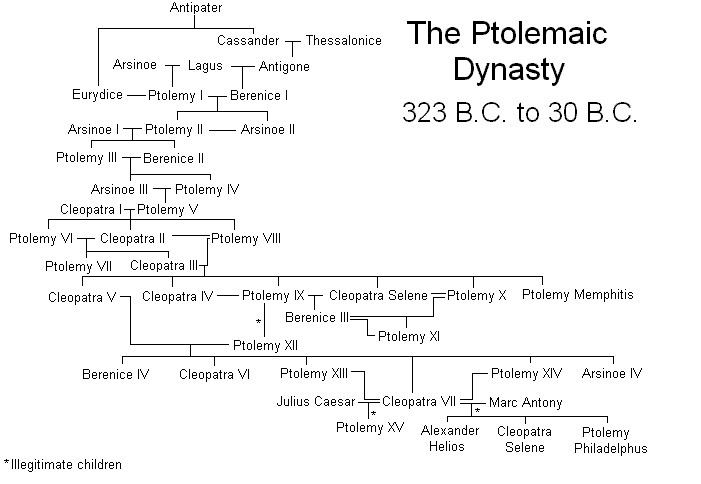Founded 305 BC Current head extinct | ||
 | ||
Similar Thirty first Dynasty of Egypt, Tenth Dynasty of Egypt, Ptolemaic Kingdom | ||
The Ptolemaic dynasty /ˌtɒləˈmeɪ.ᵻk/ (Ancient Greek: Πτολεμαῖοι, Ptolemaioi), sometimes also known as the Lagids /ˈlædʒᵻdz/ or Lagidae /ˈlædʒᵻˌdiː/ (Ancient Greek: Λαγίδαι, Lagidai, after Lagus, Ptolemy I's father), was a Greek royal family, originating from Macedon, which ruled the Ptolemaic Kingdom in Egypt during the Hellenistic period. Their rule lasted for 275 years, from 305 to 30 BC. They were the last dynasty of Ancient Egypt.
Contents
- Cleopatra Family Tree Ptolemaic Dynasty of Egypt
- Ptolemaic rulers and consorts
- Other members of the Ptolemaic dynasty
- Medical analysis
- References

Ptolemy, one of the seven somatophylakes (bodyguards) who served as Alexander the Great's generals and deputies, was appointed satrap of Egypt after Alexander's death in 323 BC. In 305 BC, he declared himself Ptolemy I, later known as Sōter "Saviour".

The Egyptians soon accepted the Ptolemies as the successors to the pharaohs of independent Egypt. Ptolemy's family ruled Egypt until the Roman conquest of 30 BC.

All the male rulers of the dynasty took the name Ptolemy. Ptolemaic queens regnant, some of whom were the sisters of their husbands, were usually called Cleopatra, Arsinoe or Berenice. The most famous member of the line was the last queen, Cleopatra VII, known for her role in the Roman political battles between Julius Caesar and Pompey, and later between Octavian and Mark Antony. Her apparent suicide at the conquest by Rome marked the end of Ptolemaic rule in Egypt.

Cleopatra Family Tree | Ptolemaic Dynasty of Egypt
Ptolemaic rulers and consorts
Dates in brackets represent the regnal dates of the Ptolemaic pharaohs. They frequently ruled jointly with their wives, who were often also their sisters. Several queens exercised regal authority. Of these, one of the last and most famous was Cleopatra ("Cleopatra VII Philopator", 51–30 BC), with her two brothers and her son serving as successive nominal co-rulers. Several systems exist for numbering the later rulers; the one used here is the one most widely used by modern scholars.
Other members of the Ptolemaic dynasty
Medical analysis
Contemporaries describe a number of the Ptolemaic dynasty members as extremely obese, whilst sculptures and coins reveal prominent eyes and swollen necks. Familial Graves' disease could explain the swollen necks and eye prominence (exophthalmos), although this is unlikely to occur in the presence of morbid obesity.
In view of the familial nature of these findings, members of this dynasty likely suffered from a multi-organ fibrotic condition such as Erdheim–Chester disease or a familial multifocal fibrosclerosis where thyroiditis, obesity and ocular proptosis may have all occurred concurrently.
